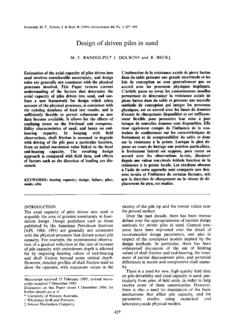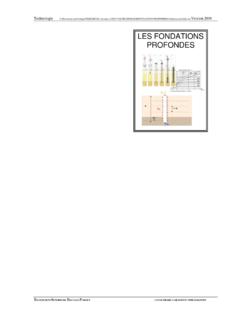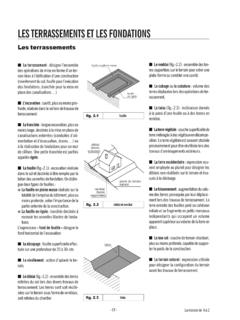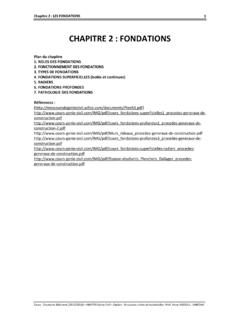Transcription of THE ULTIMATE IBARING CAPACITY OF FOUNDATIONS
1 THE ULTIMATE IBARING CAPACITY OF FOUNDATIONS . by G. G. MEYERHOF, , SYNOPSIS. In the first part of the article a theory of bearing Dans la premiere par-tie de l'article on expose une CAPACITY is developed, on the basis of plastic theory, thkrie sur la capacite de portage, baske sur la by extending the previous analysis for surface thCorie de la plasticit8, par extension de l'analyse footings to shallow and deep FOUNDATIONS in a uni- prhalable des empattements de surface aux fonda- tions faibles et profondes dans une matibre cohesive form cohesive material with fntemal friction. The uniforme avec friction inteme. Les r&sultats theoretical results are represented by bearing capa- theoriques sont reprksentb par les facteurs -de city factors in terms of the mechanical properties capacite de portage en fonction des propriMs of the soil, and the physical characteristics of the mkaniques du sol et des caractkktiques physiques foundation.
2 The base resistance of FOUNDATIONS de la fondation. La r&stance de base des fonda- in purely cohesive material is found to increase tions dans un sol vraiment coh6sif ne s'accrott que only slightly with foundation depth; for deep faiblement avec la profondeur des fondations ; pour FOUNDATIONS the skin friction is, therefore, large les fondations profondes le frottement superflciel est done grand par comparaison avec la r&stance de compared with the base resistance. In cohesionless base. Cependant, dans des matieres sans cohksion, material, however, the base resistance increases la r&istance de base s'accrott rapidement avec la rapidly with foundation depth and depends to a profondeur de fondation et depend pour une grande considerable extent on the earth pressure coefficient mesure du coefficient de pression de la terre sur la on the shaft ; for deep FOUNDATIONS the base resist- souche ; pour les fondations profondes la r6sistance ance is the predominant feature and the shin friction de base est un facteur de premibre importance et le is relatively small.
3 Frottement superiiciel n'a que peu d'importance. Dans la deuxi&me partie de l'article, on peut In the second part of the article the main results voir l'analyse des principaux r&hats d'essais de of laboratory and field loading tests on buried and charge en laboratoire et sur le terrain, sur fondations driven FOUNDATIONS are analysed and compared with enterrkes et enfondes, et la comparaison avec les the theoretical estimates. The observed base resist- previsions th&miques. La Aistance de base observke des fondations dans l'argile Concorde bien ance of FOUNDATIONS in clay is in good agreement avec les evaluations ; pour les fondations profondes with the estimates; for deep FOUNDATIONS in soft dans l'argile molle, la r6sistance de base r6elle clay the actual base resistance is somewhat less est quelque peu moindre que celle estimke en raison than estimated, on account of local sheer failure, du man ue de rksistance locale au-cisaillement, et and an empirical compressibility factor is intro- onintro3~ rut un facteur empirique de compressibilitc par lequel la resistance au cisaillement est r&d&e.
4 Duced by which the shearing strength is reduced. On trouve que le frottement superficiel depend The skin friction is found to depend largely on the beaucou sur la m&ode d'installation des fonda- method of installing the foundation. The observed tiOlZ3. E capacitb de portage observ6e pour les bearing CAPACITY of shallow FOUNDATIONS in sand fondations peu profondes clans le sable concorde is in reasonable agreement with the theory; for raisonnablement avec la Worie ; pour les fonda- deep FOUNDATIONS , however, the actual base resist- tions profondes, cependant, la rMstance de base rkelle est bien moindre que celle estimee en raison ance is considerably less than estimated on account du manque de resistance locale au cisaillement et un of local shear failure, and anempirical compressibility facteur empirique de compressibilitk est introduit factor is introduced as before.
5 Since the earth comme ci-dessus. Comme le coefficient de pression pressure coefficient on the shaft can at present de la terre sur la souche ne peut A l'heure actuelle only be deduced from tho shin friction of penetrat- &re dkluit que d'apr&s le frottement superficiel des essais de pkn6tration. il est souvent lus com- ing tests, it is frequently more convenient to estimate mode d'estimer la capacite de portage des Pondations the bearing CAPACITY of deep FOUNDATIONS in cohesion- profondes en terrain sans cohesion d'apres une less soil from an extrapolation of the results of cone extrapolation des rbsultats des essais de p&r&ration penetration tests. au cone. INTRODUCTION. The design of FOUNDATIONS must satisfy two main requirements, namely, complete failure of the foundation must be avoided with an adequate margin of safety, and the total and relative settlements of the foundation must be kept within limits that can be tolerated by the superstructure.
6 This article is only concerned with complete failure of the foundation, or its ULTIMATE bearing CAPACITY , on which a factor of safety of 3 is generally used in practice to determine the maximum safe foundation load. The settlement of the foundation under 301. 302 G. 6. MEYERHOF. this load has to be estimated independently to ascertain its effect on the stresses in the superstructure. The ULTIMATE bearing CAPACITY of a foundation is defined as the maximum load that the ground can sustain (general shear failure) ; where the load-settlement curve does not exhibit a peak load, the bearing CAPACITY is taken as the load at which the curve passes into a steep and fairly straight tangent (local shear failure) (Terzaghi, 1943). A theoretical method for estimating this bearing CAPACITY is outline in the first part of the article for cohesive materials with internal friction, and for special cases of purely cohesive and cohesionless materials.
7 The main results of laboratory and field loading tests in clay and sand are summarized, and compared with the theoretical estimates, in the second part of the article. PART I. THEORY OF bearing CAPACITY . bearing CAPACITY OF COHESIVE MATERIAL WITH INTERNAL FRICTION. The bearing CAPACITY of FOUNDATIONS depends on the mechanical properties of the soil (density, shearing strength and deformation characteristics), on the original stresses and the water conditions in the ground, on the physical characteristics of the foundation (size, depth, shape and roughness) and on the way in which the foundation is installed. In view of mathe- matical difficulties the problem can at present Figs 1. only be solved by simplified methods. This article only considers single vertical loads acting centrally on FOUNDATIONS with a horizontal base resting in a homogeneous material of great depth.
8 The bearing CAPACITY of surface and shallow FOUNDATIONS is generally estimated on the assumption that the soil is a rigid material (general shear failure) ; for deep FOUNDATIONS , when the deformation characteristics become I. Previous tllcwy Present th&y of greater importance, the compressibility of 101 SHALLOW FOUNDATION the material is usually taken into account by an empirical reduction of the shearing strength (local shear failure). The influence on the soil properties of the method of installing the foundation is also based on empirical evidence. For a material whose shearing strength is given by the equation s = c + p tan 4 (Coulomb-Mohr's theory of rupture) .. (1). where c denotes unit or apparent cohesion, 4 )P angle of internal friction or shearing resistance, and P ,, normal pressure on shear plane, Terzaghi (1943) has shown that the bearing CAPACITY q of a shallow strip foundation of width B and depth D (Fig.
9 1 (a)) can be represented by the expression (b) DEEP FOUNDATION. Plastic zones near rough strip foundation bearing CAPACITY OF FOUKDATIONS 303. where PO denotes overburden pressure at base level, .' Y density of material, and NC, N, and NY are the bearing CAPACITY factors for a surface footing and depend on 4 and the roughness of the base. For a similar deep foundation ( (b)) Terzaghi has indicated that the bearing CAPACITY is approximately equal to that given above, with the additional effects of the skin friction along the foundation shaft and the shearing stress along a vertical outer boundary of the mass of soil adjacent to the foundation. The above analysis is based on plastic theory, and the corresponding zolies of plastic equilibrium in the material are shown in Figs 1 for the case of a rough foundation. Below the base is a central zone ABC; which remains in an elastic state of equilibrium and acts as part of the foundation ; on each side of this zone there are two plastic zones, a zone of radial shear, ACD, and a zone of plane shear, ADE, identical to those below a similar surface footing.
10 In the case of a shallow foundation the shearing strength of the overburden is ignored and only its weight is taken into account as an equivalent surcharge, p,, equal to yD. This method has been found to be conservative, and the assumed mechanism of failure usually not in accordance with the observed ground movements (Meyerhof, 1948). For a deep foundation the corresponding method suffers from the difficulty that when the failure surface no longer reaches the ground level, the height over which the shearing strength of the soil is mobilized becomes very uncertain and must be assumed. In an attempt to overcome these limitations the Author has extended the previous analysis of the plastic equilibrium of a surface footing to shallow and deep FOUNDATIONS . According to this theory the zones of plastic equilibrium increase with foundation depth to a maximum for a deep foundation (Figs 1).





